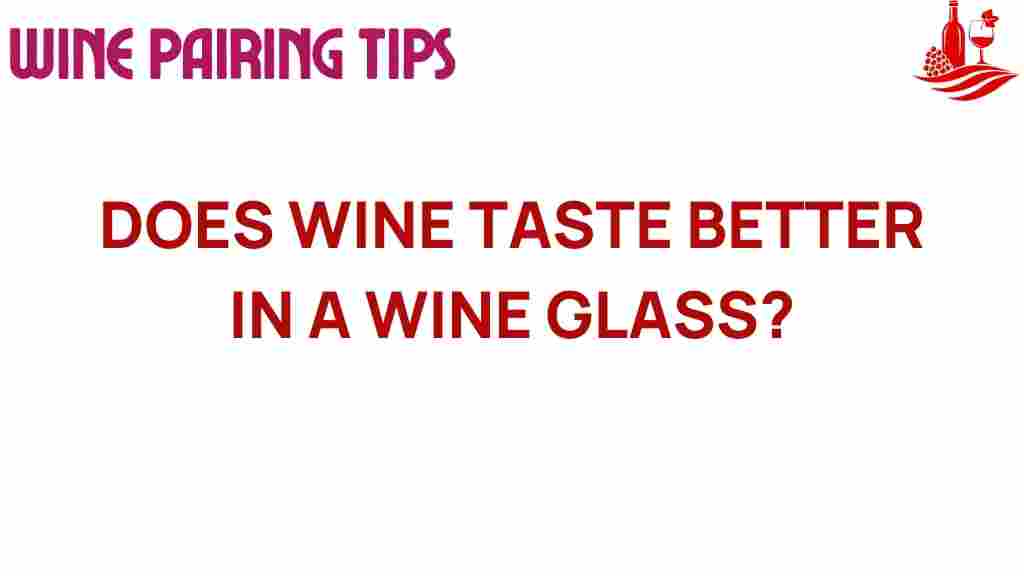Does Wine Taste Better in a Glass? Unveiling the Truth Behind the Vessel
Wine tasting is an art form that engages the senses and elevates the drinking experience. While many factors contribute to the overall enjoyment of wine, the vessel from which it is consumed plays a significant role. This article will explore whether wine tastes better in a glass, examining the impact of wine glass design, tasting experience, and other factors that influence wine quality and enjoyment. We will delve into aspects such as beverage presentation, glass shape, sensory perception, aroma enhancement, and drinking etiquette.
The Importance of the Right Glass
The choice of glass can dramatically affect the taste and aroma of the wine. Here are several reasons why using a proper wine glass is essential:
- Shape and Size: Different wines benefit from specific glass shapes that allow for optimal aeration and aroma release.
- Material: Glasses made from fine crystal can enhance the clarity and color of the wine, improving the visual presentation.
- Temperature Control: A good wine glass can help maintain the ideal temperature for serving wine, which is crucial for flavor.
Understanding the Tasting Experience
The overall tasting experience involves much more than simply sipping the wine. Here’s how the right glass enhances this experience:
- Aroma Enhancement: The shape of the glass can concentrate the aromas, allowing for a more profound olfactory experience.
- Visual Appeal: The clarity and design of a fine wine glass can elevate the overall presentation of the beverage.
- Texture and Weight: The feel of a glass in hand can influence the perception of a wine’s body and richness.
Choosing the Right Glass for Different Wines
To fully appreciate the diverse profiles of various wines, it’s important to match the wine with the appropriate glass. Here’s a guide to selecting the right glass for popular wine types:
Red Wines
Red wines typically benefit from larger, bowl-shaped glasses. This design allows for greater aeration, enhancing the wine’s complex aromas and flavors.
- Cabernet Sauvignon: A wide bowl to allow for aeration and aroma release.
- Pinot Noir: A slightly narrower bowl that helps concentrate the delicate aromas.
White Wines
White wines are usually served in smaller glasses to maintain their cooler temperatures and to preserve the crispness of the wine.
- Sauvignon Blanc: A medium-sized glass to enhance its zesty aromas.
- Chardonnay: A glass with a slightly wider bowl to allow for the wine’s richness to shine.
Sparkling Wines
Champagne and sparkling wines are best served in flutes or tulip-shaped glasses, which help retain bubbles and enhance the aroma.
- Champagne Flute: A tall, narrow glass that keeps bubbles intact.
- Tulip Glass: Offers more space for aromas while still maintaining carbonation.
Drinking Etiquette: The Role of Glassware
When it comes to drinking etiquette, the type of wine glass used can convey respect for the wine and the occasion. Here are some tips:
- Choose Appropriate Glassware: Always select the right glass for the type of wine you are serving.
- Hold by the Stem: When drinking, hold the glass by the stem to avoid warming the wine with your hand.
- Presentation Matters: A well-set table with appropriate glassware enhances the dining experience.
Step-by-Step Process to Enhance Your Tasting Experience
To truly appreciate the nuances of wine, follow these steps:
1. Select Your Wine
Choose a wine that intrigues you or one that complements your meal.
2. Choose the Right Glass
Match your wine with the appropriate wine glass to maximize your tasting experience.
3. Observe the Wine
Look at the color and clarity of the wine. The right glass will enhance its visual appeal.
4. Swirl and Smell
Gently swirl the wine in the glass to release its aromas. Take a moment to inhale the fragrance before tasting.
5. Taste and Savor
Take a small sip and let the wine coat your palate. Pay attention to the flavors and mouthfeel.
6. Reflect
Consider what you like or dislike about the wine. The right wine glass can enhance your ability to identify these characteristics.
Troubleshooting Tips for Wine Tasting
If you find that your wine doesn’t taste as good as expected, consider the following:
- Check Your Glass: Ensure you are using the correct type of wine glass for the wine.
- Temperature Matters: Ensure the wine is served at the correct temperature for its type.
- Aging Considerations: Some wines require aging to reach their full potential; consider this before tasting.
For more information on wine tasting techniques, check out this helpful guide.
Conclusion
In conclusion, the vessel from which wine is consumed significantly impacts the overall tasting experience. The right wine glass not only enhances wine quality through aroma enhancement and sensory perception but also elevates the beverage presentation and demonstrates proper drinking etiquette. Whether you are a seasoned connoisseur or a casual drinker, understanding the importance of glass shape and design can vastly improve how you appreciate each sip. Embrace the art of wine tasting and enjoy the full experience that the right glass can provide!
This article is in the category Tasting and created by Wine Pairing Tips Team
